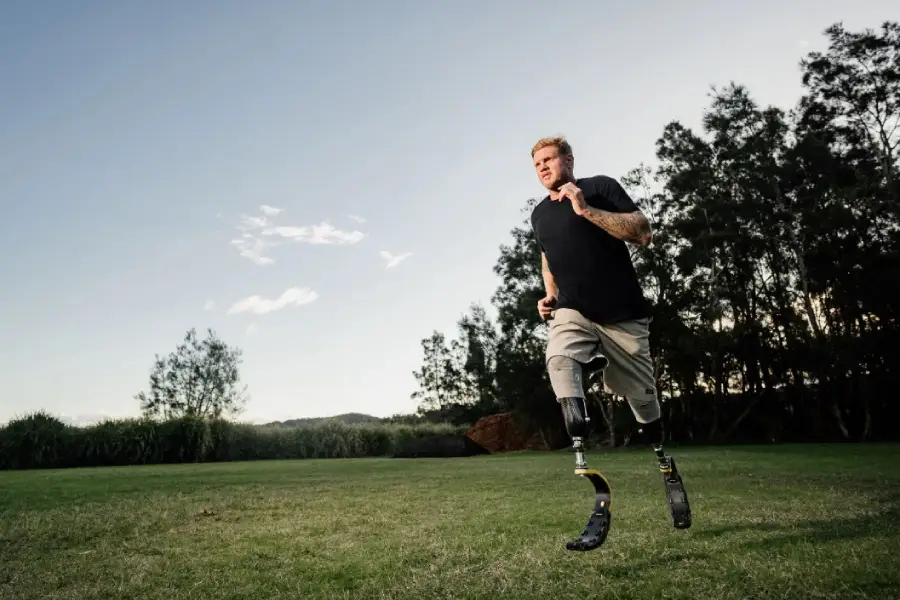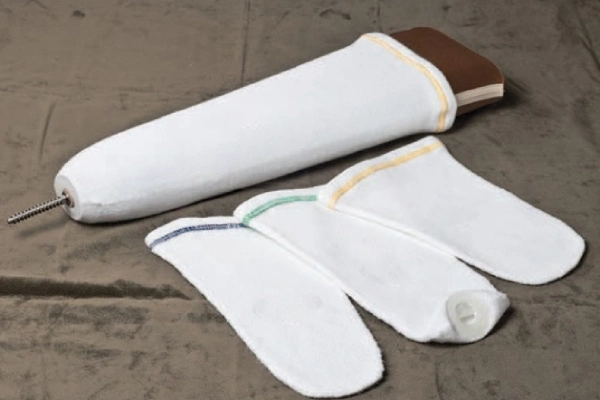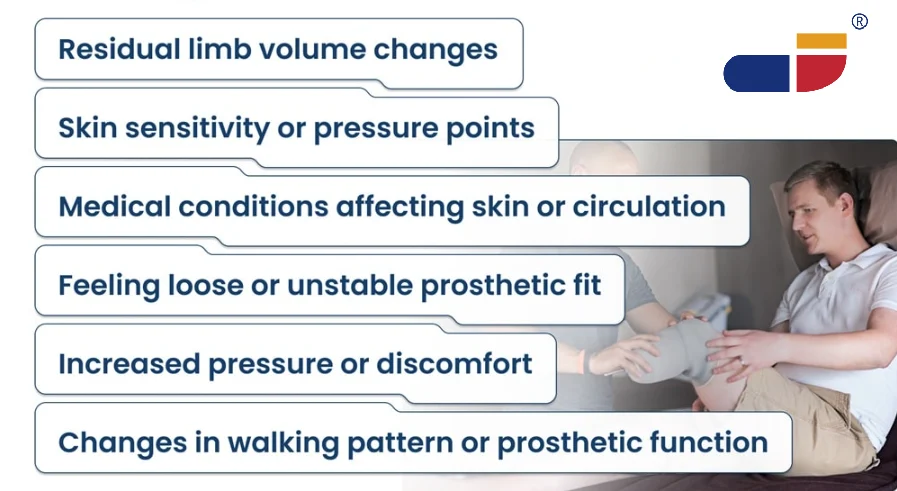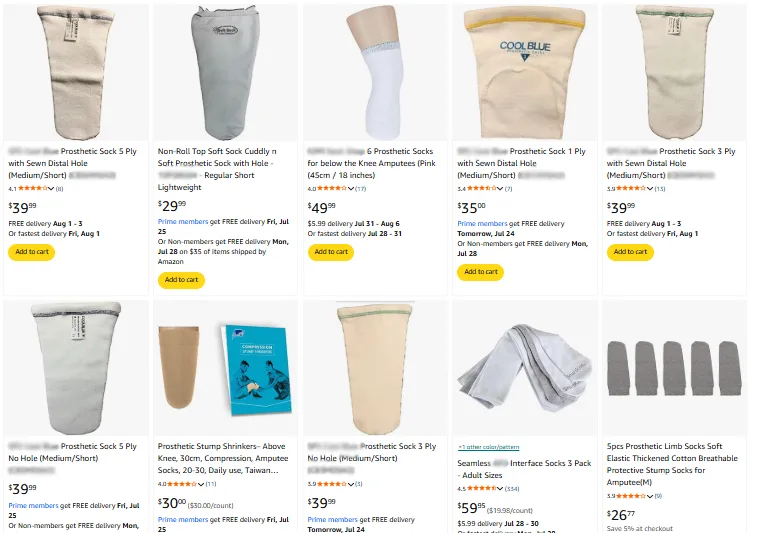
Many first-time prosthetic users face unexpected discomfort within just a few hours of wear:
- Itchy or irritated skin
- Fluctuating socket tightness
- Uneven pressure leading to instability or fatigue
Often, these issues aren’t caused by the prosthetic device itself—but by the absence of one overlooked accessory: the stump sock.
What Is a Stump Sock?

A stump sock (also called a prosthetic sock or prosthetic ply sock) is a specialized tubular garment worn over an amputee’s residual limb (stump) inside a prosthetic socket. Unlike ordinary socks, stump socks have no heel and are engineered to match the shape of the limb. They provide cushioning, protect the skin, and help maintain a snug, comfortable fit of the prosthesis. Made from wool, cotton, synthetic fibers, or blends, these socks may include special yarns or coatings (for example, moisture-wicking fabrics or antibacterial treatments). Stump socks come in various thicknesses (known as “ply”) and styles to suit different needs. When a prosthesis is fitted, the prosthetist typically provides an initial supply of stump socks in a range of plies (commonly 1-ply, 3-ply, and 5-ply). This allows the amputee to adjust sock thickness to achieve the best fit and comfort throughout the day.
Why Do People Really Need Stump Socks?

The need for stump socks becomes obvious when users encounter challenges that go beyond discomfort. Here’s a closer look at four real-life problems that stump socks directly address:
Daily Limb Volume Fluctuation
Residual limbs swell and shrink slightly throughout the day. Without a stump sock, this can lead to socket looseness, chafing, or the prosthetic shifting uncomfortably. Stump socks with varying thicknesses (measured in “ply”) help fine-tune the fit. For more on safe wearing duration, read Can You Wear a Stump Sock All Day and Night?
Skin Redness and Hotspots
Especially in the early weeks of use, the prosthetic socket may create pressure points. A stump sock adds a cushioning barrier that distributes contact forces more evenly across the limb.
Moisture and Bacterial Risk
High activity levels or warm weather can cause sweating inside the socket. Moisture-wicking socks reduce the risk of odor, fungal infections, and skin maceration by maintaining a drier environment.
Lack of Prosthetic Education
Many new amputees don’t receive sufficient guidance on sock use, leading to improper selection or wear. The result: discomfort, wasted cost, and confusion about whether the prosthesis itself is “wrong.”
Types of Stump Socks

Category by Key Materials Used
- Wool socks: Wool is a traditional choice. Wool fibers offer natural cushioning and absorb moisture well. These socks tend to be warm, which can be a benefit or drawback depending on climate. Some users find pure wool itchy, so many wool socks are blended with synthetics.
- Cotton socks: Cotton is soft and breathable but holds moisture. Cotton stump socks can be comfortable, but they may feel damp unless changed frequently.
- Synthetic blends: Many modern socks mix materials like nylon, acrylic, spandex (Lycra), or polyester. These blends are designed to be durable, stretchy, and sometimes incorporate moisture-wicking fibers. For example, nylon-spandex blends can give a snug, elastic fit.
- Advanced fabrics: Some specialty socks use high-tech yarns. For instance, silver-infused threads are used to reduce odor and bacteria. Other high-tech fibers actively draw sweat away from the skin. Manufacturers also make sock sheaths with antibacterial treatments.
Category by ply
- 1-ply (Lightweight): Very thin (often under 2mm). Used for minor volume adjustments or for very tight spaces.
- 3-ply: Medium thickness (about 2–4mm). Useful for moderate volume changes and is a common standard sock.
- 5-ply: Thick (roughly 5–6mm). Suitable for significant volume difference or high-impact activity where extra cushion is needed.
- 8-ply and higher: Available for large volume compensation, though less common. These can be bulky and are used only when a lot of adjustment is needed.
Keep in mind that ply is not standardized across brands. A 3-ply sock from one company may be thicker or thinner than a 3-ply from another, depending on the material. For example, a 5-ply wool sock often feels much thicker than a 5-ply nylon sock because of the loftier fibers in wool.
Specialty prosthetic socks
- Gel-impregnated socks: These have a layer of soft gel (often mineral oil-based) woven into them. The gel provides extra cushioning and skin protection, especially over pressure spots. They can also help hold weak skin together.
- Half-socks: These cover only part of the limb (for example, the end or anterior half) to accommodate asymmetrical volume loss. They are used less frequently than full socks.
- Thin sheaths (cosmetic or drying sheaths): These ultrathin socks (often nylon) go directly against the skin under the main socks or liner. They primarily wick sweat and protect the skin from direct contact with the liner or sock.
- Moisture-wicking or antibacterial socks: As mentioned above, these use treated fabrics to keep the skin dry and reduce odor-causing microbes.
Choosing the right type of stump sock depends on individual needs: how much volume fluctuation occurs, how sensitive the skin is, climate, and personal comfort. Often amputees keep a variety of socks (different materials and plies) and try them over time to see what works best.
| Type | Best For | Material | Key Feature |
|---|---|---|---|
| Knit Ply Sock | Daily volume adjustment | Cotton/Wool blends | Layered use possible |
| Gel-Lined Sock | Sensitive skin / bony limbs | Fabric + Medical-grade gel | Pressure relief and cushioning |
| Moisture-Wicking Sock | Active users / warm climates | Bamboo, Coolmax, Silver | Sweat and odor control |
| Compression Stump Sock | Post-op or swelling control | Nylon + Elastane | Targeted limb compression |
How to Wear and Maintain a Stump Sock

Stump socks should always be worn before putting on the prosthetic liner and socket. Before wearing, check the sock for any holes or damage to avoid skin irritation.
Wash socks daily with mild detergent and let them air dry—avoid using bleach or machine dryers, which can damage the material. Most users replace their stump socks every 3 to 6 months depending on wear and activity level.
Stump socks protect the residual limb, improve prosthetic fit, and support daily comfort. They’re essential for managing moisture, friction, and limb volume changes throughout the day.
If your brand or clinic needs custom stump socks in bulk, reach out to us to learn more or request samples.
FAQ
Q1: What does “ply” mean in stump socks?
Ply refers to the thickness of the sock. A 1-ply sock is thin, while multiple plys (layers) allow users to adjust the fit of their prosthetic socket by adding or removing thickness.
Q2: Can I wear more than one stump sock at the same time?
Yes. Layering stump socks is a common practice to manage residual limb volume changes and achieve a better fit throughout the day.
Q3: Are stump socks unisex?
Most stump socks are designed based on limb circumference rather than gender, making them unisex and suitable for all users.
Q4: How often should stump socks be replaced?
Replacement is typically recommended every 3 to 6 months, depending on the frequency of use, washing, and signs of wear like thinning or loss of elasticity.
Q5: Are stump socks covered by insurance?
In many countries, stump socks may be covered under Durable Medical Equipment (DME) or rehabilitation supply benefits. Coverage varies, so checking local insurance policies is advisable.
